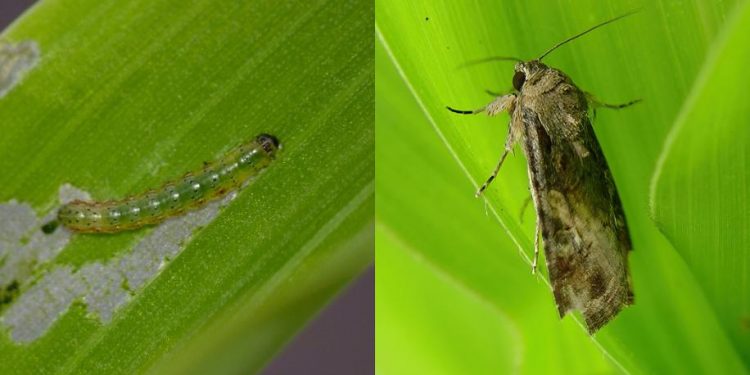Fall armyworm, Spodoptera frugiperda (J.E. Smith) (Lepidoptera: Noctuidae), is a voracious pest of various crops, especially grasses, such as maize, rice, and sugarcane, but also vegetables and cotton. Originally from the tropical and subtropical regions of the Americas, it recently spread around the world: it was found in São Tomé and Príncipe, Benin, Nigeria, and other African countries in 2016; in India in 2018; in China, South Korea, Japan, and other Asian countries in 2019; and in Australia in 2020. In China, it has infested many provinces, from south and southwest regions to the north-eastern ‘corn belt’. Recently, the species was also found in Cyprus. Fall armyworm adults can migrate long distances, which is likely an important factor in its success as a pest . In addition, larvae can disperse by crawling or ballooning (i.e., aerial dispersal using silk threads).
Fall armyworm populations can be resistant to a number of pesticide active substances . Therefore, integrated pest management (IPM) is important, relying on a combination of chemical, physical, and biological control. Commonly used tools for fall armyworm control consist of insecticides, including Bt products, and genetically modified Bt crops , and the search for new insecticides continues . Push-pull companion cropping is also being investigated as a potential control method . Various compounds of the female’s sex pheromones, released to attract conspecific males, have been identified, and a commercial lure is available to monitor and/or trap fall armyworm .
Interestingly, fall armyworm is able to detoxify specific defense compounds in maize, as well as suppress maize defense mechanisms . Indeed, its gut microbes impact defense responses . Therefore, fall armyworm’s microbiota may also contribute to its status as an important pest world-wide . Interactions with other insects, such as competing herbivores and natural enemies, affect fall armyworm performance. In its native region, fall armyworm is a host to a large variety of parasitoid wasps and flies , some of which are commercially available . The species is also frequently attacked by predators, fungi, viruses, and entomopathogenic nemathodes . It is important to monitor the presence of natural enemies in invasive areas, to assess their potential as biological control agents.
Reference: de Lange ES, Xiao Y & Beukeboom LW (2023) Biology of fall armyworm – an introduction. Entomologia Experimentalis et Applicata 171: 488–491. https://doi.org/10.1111/eea.13324
Error




